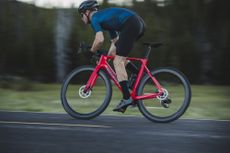Wahoo Kickr Bike review
The at home exercise bike with seemingly endless adjustability - at a price
- (opens in new tab)
- (opens in new tab)
- (opens in new tab)
- Sign up to our newsletter Newsletter
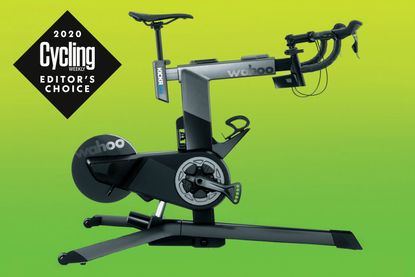
With its Kickr Bike, Wahoo has really broken new ground. No other exercise bike offers the gradient adjustments we have here, and this makes indoor cycling both more fun and more realistic, potentially having a greater transfer out on the road. The adjustable shifters are excellent, as is the ride quality. The price hike over the competition is quite substantial, those shelling out this much cash will want perfection. For that reason, the lack of device holder and stickiness in some adjustments (on our second hand test model) do need addressing.
-
+
Bike fit app
-
+
Climb feature
-
+
Adjustability
-
+
Ride feel
-
-
No phone/tablet holder
-
-
Expensive
-
-
Some adjustments stiff
Why you can trust Cycling Weekly Our expert reviewers spend hours testing and comparing products and services so you can choose the best for you. Find out more about how we test.

The Wahoo Kickr Bike was selected for an Editor's Choice award (opens in new tab) in 2020. This year's list contains 78 items which scored a 9 or 10/10 with our tech team - this gear is the best of the best, and has received the Cycling Weekly stamp of approval.
The Wahoo Kickr Bike is one of the new breed of indoor bikes which set their sights firmly at the dedicated cyclist market. The bike offers easy adjustment, to ensure riders can perfectly mimic their bike set-up, as well as gradient adjustments via the in-built Kickr Climb feature (from -15% to +20%) and a realistic ride feel.
It's not perfect, though.
Before we dive in, it's worth noting that we have a page dedicated to the best exercise bikes and smart indoor bikes (opens in new tab)for home workouts that will allow you to compare all the top models on offer at the moment.
Arrival and set up
Our test model arrived ready-built, being a media sample shipped (we assume) from appearance at a show or from testing with another title. So I can't talk about the build process.
I did however need to remove the legs to carry the Kickr up the stairs. This was a simple job, completed with an Allen key. I could move the bike around quite easily - despite its 42kg heft - thanks to the wheels at the rear of the bike.
The set up process is made possible via the Wahoo app.
To set up fit, you can do one of the following - with the options listed in order of expected accuracy:
- Enter measurements from a bike fit (Retül, Trek Precision or Guru),
- Take a photo of a bike that fits well and mark out key points
- Enter your body measurements
The app then spits out simple instructions which are easy to follow using the ruler markers on the bike.
Testing options one and two, I got similar but not identical readings. Firstly, the bikes aren't identical - so that'll explain some difference. The saddle height discrepancy is greater than it should be, though.
Using the 'bike photo' option, you need to mark the position of the centre of the crankset and handlebars via placing a marker on the screen on your phone. I don't trust my chubby fingers as much as I do the 'Zin' machine used at a Retül fit, so I'd advise new users to use bike fit measurements if they have them available.
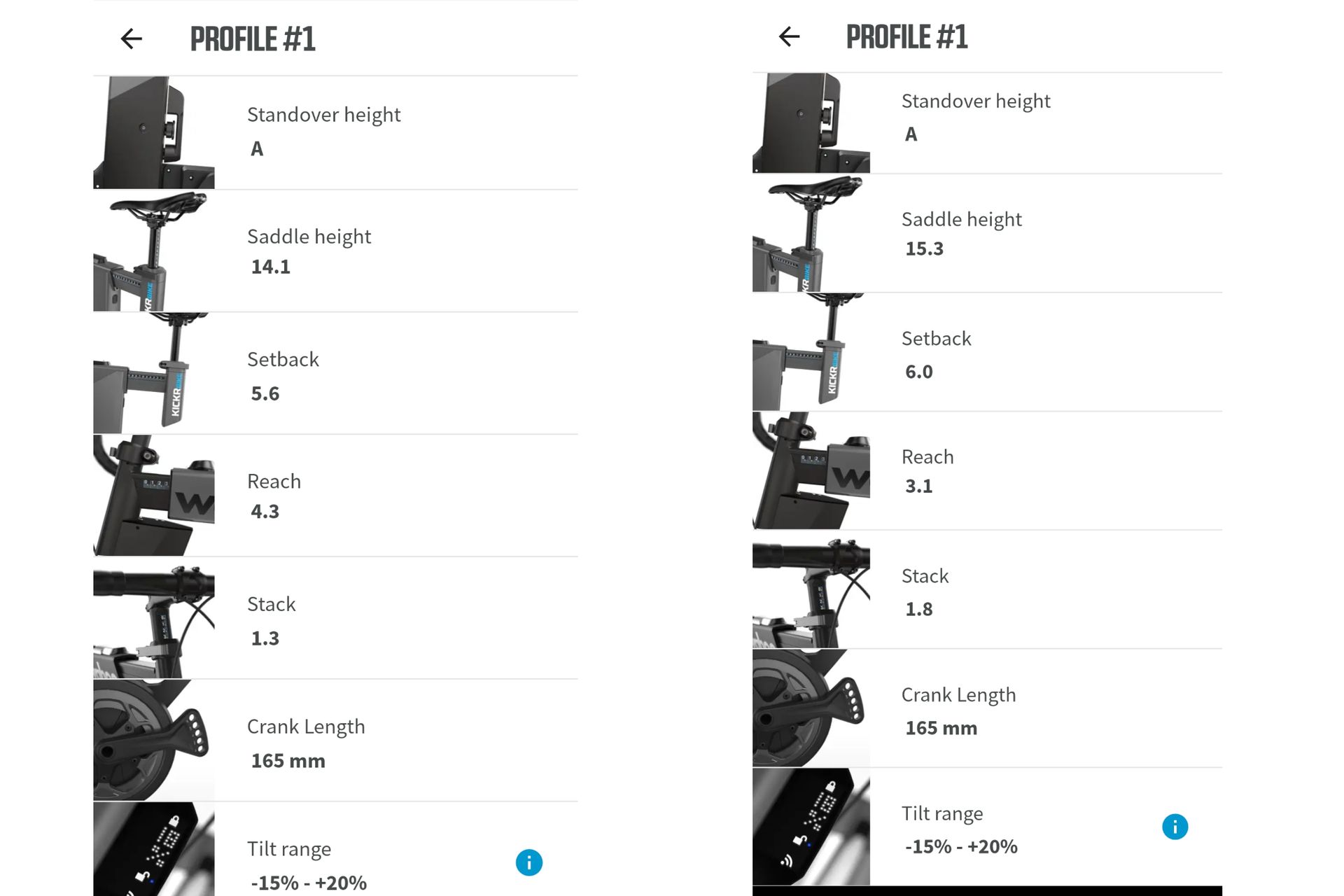
I found some of the adjustment levers quite stiff - particularly the reach. However, remember that my test unit might well be an ex-show model. It won't have had the same life as a customer model which has spent its days in a loving home.
It is possible to use a different seatpost, which is handy if more than one person is using the bike. The specced bars are 40cm (centre to centre) but the shifters do come off as per a normal pair so you could swap these if required.
Crank length can be anything from 165cm to 175. If you're using a pedal with a longer axle, such as Garmin Vector 3's, you'll need to use a spacer to stop the pedal spindle rubbing the body of the bike.
The bike can adjust to fit riders between 5ft (152cm) and 6ft4 (192cm), so it won't be suitable for a family unit with people outside of that range. Also, those on the smaller end may not be able to enjoy the full range of the downward tilt. Adjusting my saddle height to 13cm in the app, a message warned me that I'd only get to -10% on the gradient adjuster.
You can then set up your preferred braking and shifting preference. For this bike, Wahoo developed its own shifters, and they're seriously neat. I set mine up to mirror Shimano's system and they worked perfectly.

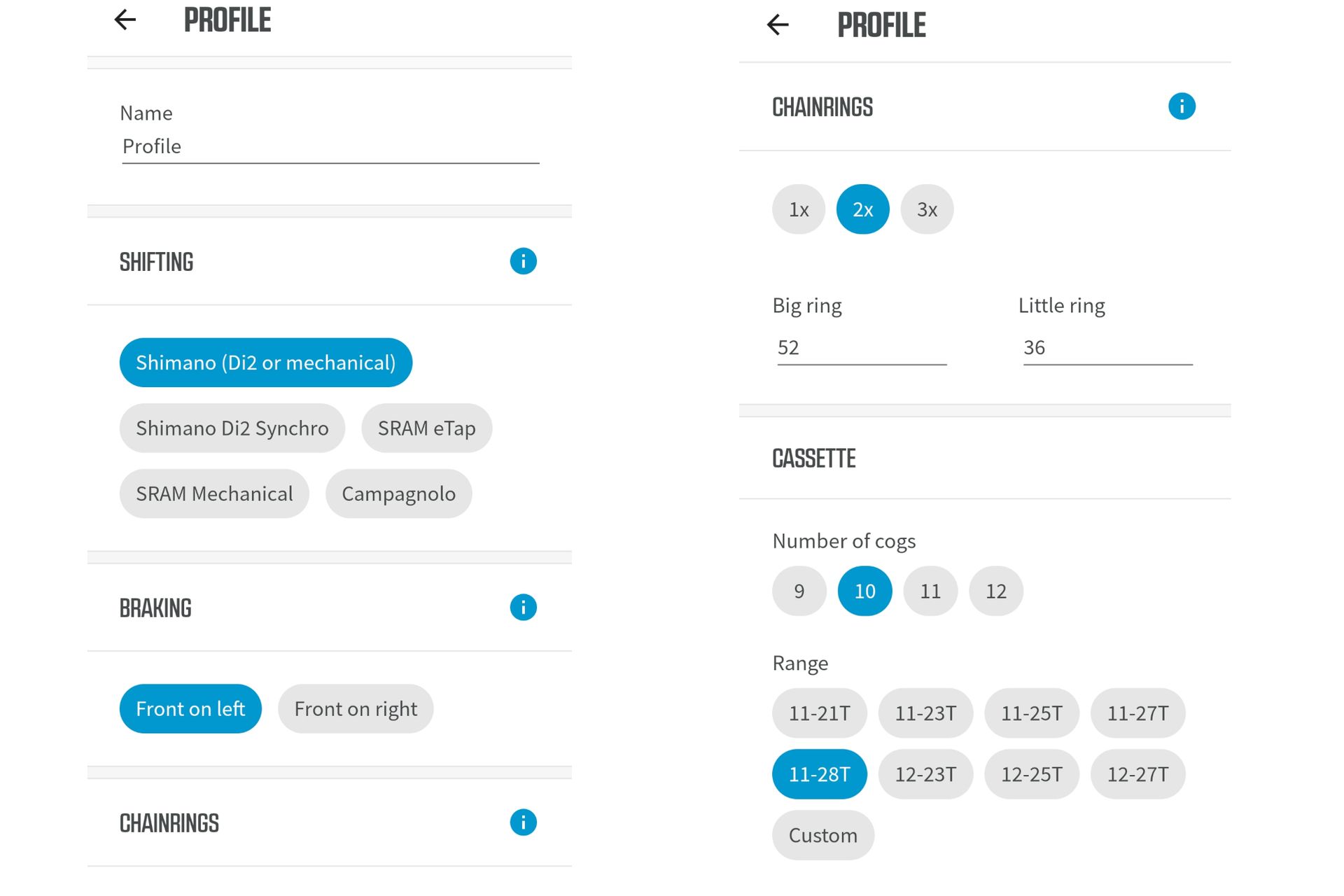
Pulling the brakes makes it much harder to pedal. However, platforms such as Zwift don't yet support braking, so though the Kickr Bike is 'future ready' (in case this feature becomes part of the Zwift racing tactics) you wouldn't want to use them just yet!
You can adjust the gradient via the buttons on top of the shifter. Doing this locks the system, so it can't be controlled by apps like Zwift. Wahoo told me this was to avoid automatic adjustments resulting in "the cat's tail getting caught in the mechanism." To unlock it - meaning platforms can adjust gradient automatically - simply press the grey button on the outside of the display box for 3 seconds.
The display itself is located on the right side of the top tube and shows you what gear you're in, plus percentage gradient as it adjusts.
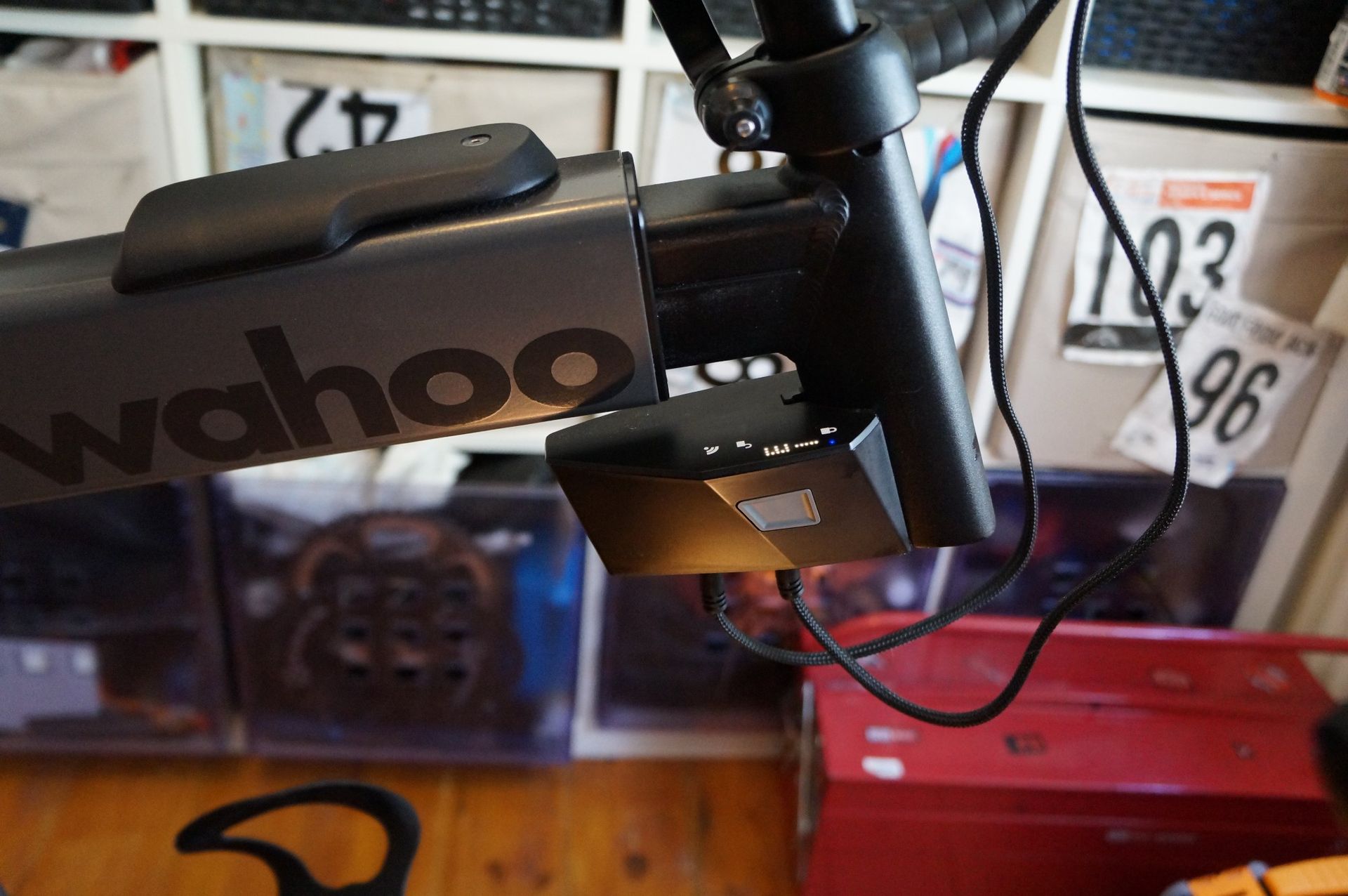
Rather unfortunately, there's nowhere to place a phone or tablet. Given the £2999.99 price tag, this seems like a pretty glaring omission, I'd be shocked if Wahoo didn't add this in the next generation of the product.
Ride quality
The Kickr bike utilises a 5.9kg electromagnetic flywheel to provide the realistic ride feel. Tacx also uses an electromagnetic system, and Wattbike adopted the tech in its latest Atom.
Electromagnetic resistance means that adjustments to the motor happen instantly - as opposed to magnets physically moving towards and away from the flywheel to adjust the braking force. This means that changes in resistance are much quicker - which is better when mimicking the hills of Zwift as well as reacting during sprint sessions.
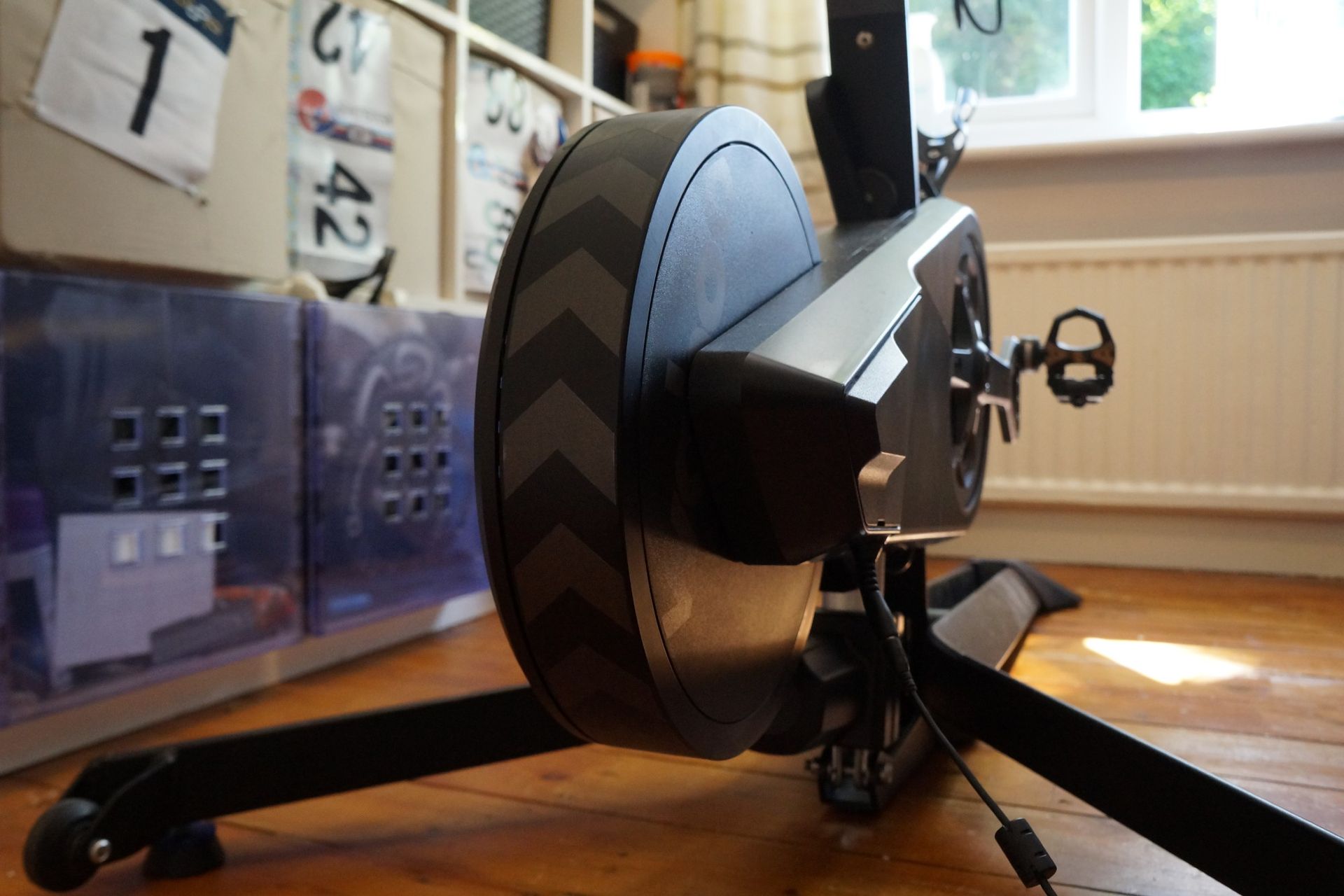
The ride feel is incredibly natural. I found my cadence was quicker than when using my own bike attached to a turbo trainer.
The in-built motor meant that if I got off when hooked up to Zwift - on a flat surface of descent - the pedals would keep turning for a few seconds which was a slightly odd thing to see. This makes sense in a way - if you jump off your bike at 30kph it keeps moving, too.
Wahoo has built in a reassuring 'clunk' when you shift between gears, which adds to the natural ride feel.
Resistance and climbing gradient adjustments in ERG mode were quick and effective. Whilst initially I thought the Climb feature was a bit of a gimmick, ramping up over 15 per cent my body was forced to work as it would out the saddle on a real climb - so I can see a lot of real world crossover here. I'm still not sure the descent feature has any physiological benefit, but it's good fun.
During training sessions, I tend to switch ERG mode off, and changing the resistance via the shifters worked well.
Stability and noise
The max resistance on offer is 2200 Watts. Clearly, I couldn't even dream of exceeding this, but sprinting out the saddle I had a strong and sturdy base to work against. I had hoped this would allow me to reach max power numbers comparable to those outside, but alas this was not the case - my max indoor power was no different to that achieved on a standard turbo trainer with my bike fitted.
The top tube is quite wide. During the first easy sessions this wasn't an issue, but I did find when really pounding the pedals my thigh would contact it. This didn't really bother me or leave any marks - I've had far worse with protruding cables on standard bikes.
Whilst we're on the topic, the Q-factor is 150mm - 10mm narrower than the Wattbike Atom, taking it slightly closer to the feel of an average road bike. Being female with fairly wide hips, I've always wondered if I'd be better off adjusting my pedal spindle to go wider - but some might like the familiarity on offer here.
The motor itself is extremely quiet - emitting a similar level of hum to a standard turbo trainer.
Early on, I did notice some creaking. First I thought it was the unit being uneven on my rickety floorboards. Adjusting the rear feet (a bit like popping a napkin under a chair leg) made no difference. After several hours of frustration, I finally noted that the standover height lever wasn't adequately clicked into place. Resetting this fixed the issue.
Accuracy and connectivity
The Wahoo Kickr has a promised power meter accuracy range of +/- 1%. This refers to how accurate the power meter is to itself - so 250 watts on my Wahoo Kickr Bike test unit should read anywhere between 247 and 252 watts at any given time. As studies have shown, 'trueness' (and thus comparison to other power meters) is another topic and power meter brands, models and units within one model class will read slightly differently.
I tested the Kickr with my PowerTap P2 pedals fitted. There was deviation between the two - comparing a 55 minute session recorded on both, the Wahoo average power is 3.9% higher whilst the max power is 3.5% higher on the P2 data. Typically I found the P2s gave lower readings during endurance efforts, but both were within range of zones set by my coach.
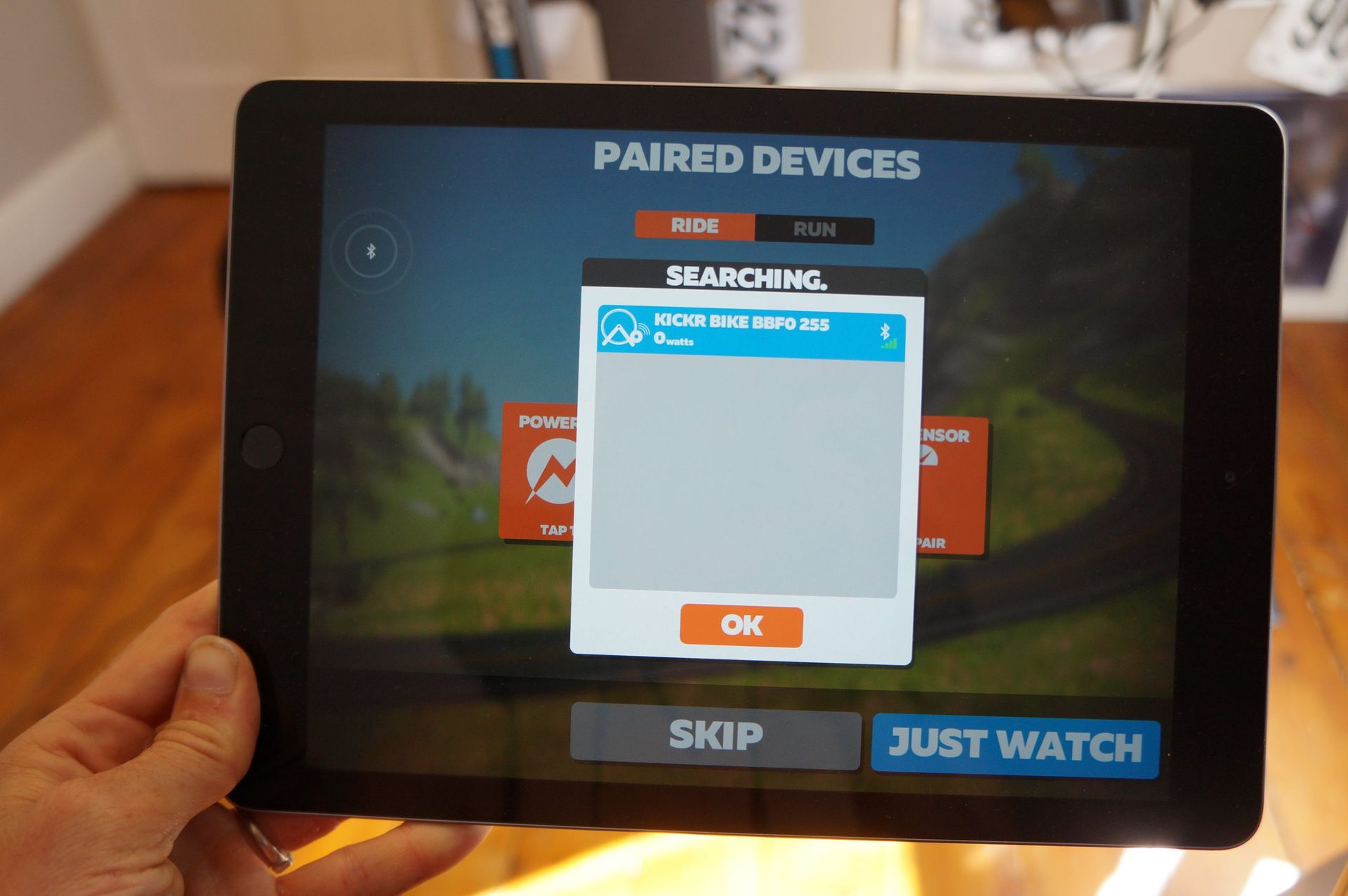
The Kickr Bike offers ANT+ and Bluetooth connectivity, and I could always find it within the sensors on my Garmin, on Zwift and when making adjustments in the app on my phone.
Value
Wahoo has priced its bike at £2999.99. That's rather a lot higher than competitors - the Tacx Neo at £2299.99 and the Wattbike Atom - now £1899.99, (in its new model) up from the 10/10 scoring outgoing model at £1599. All three use an electromagnetic resistance system and cater for 2200 watts+. The Kickr bike does however offer you an experience like no other with its custom shifters and the Climb gradient feature.
There's also the comparison to the traditional option to consider. A Wahoo Kickr turbo trainer would set you back £999.99, and a Climb £499 - leaving you £1500 leftover to buy a dedicated turbo bike. However, for a family with several adult height riders wanting to hop on, the Kickr Bike option starts to make a lot more sense.

Thank you for reading 10 articles this month* Join now for unlimited access
Enjoy your first month for just £1 / $1 / €1
*Read 5 free articles per month without a subscription

Join now for unlimited access
Try first month for just £1 / $1 / €1
Michelle Arthurs-Brennan is a traditional journalist by trade, having begun her career working for a local newspaper, where highlights included interviewing a very irate Freddie Star (and an even more irate theatre owner), as well as 'the one about the stolen chickens'.
Previous to joining the Cycling Weekly team, Michelle was Editor at Total Women's Cycling. She joined CW as an 'SEO Analyst', but couldn't keep her nose out of journalism and in the spreadsheets, eventually taking on the role of Tech Editor before her latest appointment as Digital Editor.
Michelle is a road racer who also enjoys track riding and the occasional time trial, though dabbles in off-road riding too (either on a mountain bike, or a 'gravel bike'). She is passionate about supporting grassroots women's racing and founded the women's road race team 1904rt.
Michelle is on maternity leave from July 8 2022, until April 2023.
-
 High-end bikes still in demand says Giant, as it announces 12.5% revenue increase
High-end bikes still in demand says Giant, as it announces 12.5% revenue increaseBut like much of the industry the Taiwanese manufacturer is also experiencing a surplus of low to mid priced stock
By James Shrubsall • Published
-
 Milan-San Remo 2023: Route and start list
Milan-San Remo 2023: Route and start listAll you need to know about the first Monument of the 2023 season
By Ryan Dabbs • Published
-
 Summit finish and final day time-trial for 2024 Tour de France finale in Nice
Summit finish and final day time-trial for 2024 Tour de France finale in NiceStage 20 will finish atop the Col de la Couillole before final day race against the clock in Nice
By Tom Thewlis • Published
